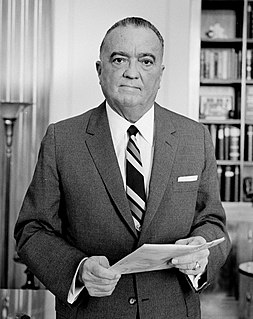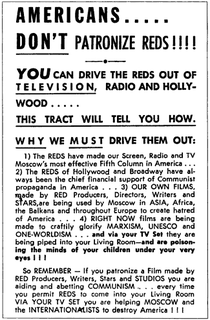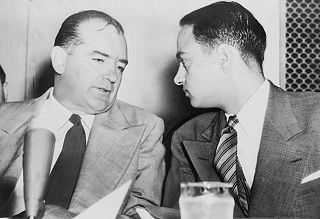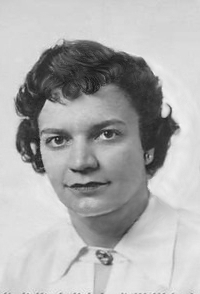
John Edgar Hoover was an American law enforcement administrator who served as the first Director of the Federal Bureau of Investigation (FBI) of the United States for nearly 48 years. He was appointed director of the Bureau of Investigation – the FBI's predecessor – in 1924 and was instrumental in founding the FBI in 1935, where he remained director for another 37 years until his death in 1972 at the age of 77. Hoover has been credited with building the FBI into a larger crime-fighting agency than it was at its inception and with instituting a number of modernizations to police technology, such as a centralized fingerprint file and forensic laboratories. Hoover is also credited with establishing and expanding a national blacklist, referred to as the FBI Index or Index List, renamed in 2001 as the Terrorist Screening Database which the FBI still compiles and manages.

McCarthyism is the practice of making accusations of subversion and treason, especially when related to communism and socialism. The term originally referred to the controversial practices and policies of U.S. Senator Joseph McCarthy (R-Wisconsin), and has its origins in the period in the United States known as the Second Red Scare, lasting from the late 1940s through the 1950s. It was characterized by heightened political repression and persecution of left-wing individuals, and a campaign spreading fear of alleged communist and socialist influence on American institutions and of espionage by Soviet agents. After the mid-1950s, McCarthyism began to decline, mainly due to Joseph McCarthy's gradual loss of public popularity and credibility after several of his accusations were found to be false, and sustained opposition from the U.S. Supreme Court led by Chief Justice Earl Warren on human rights grounds. The Warren Court made a series of rulings on civil and political rights that overturned several McCarthyist laws and directives, and helped bring an end to McCarthyism.

The Internal Security Act of 1950, 64 Stat. 987, also known as the Subversive Activities Control Act of 1950, the McCarran Act after its principal sponsor Sen. Pat McCarran (D-Nevada), or the Concentration Camp Law, is a United States federal law. Congress enacted it over President Harry Truman's veto. It required Communist organizations to register with the federal government. The 1965 U.S Supreme Court ruling in Albertson v. Subversive Activities Control Board saw much of the act's Communist registration requirement abolished. The emergency detention provision was repealed when the Non-Detention Act of 1971 was signed into law by President Richard Nixon. The act's Subversive Activities Control Board, which enforced the law's provision calling for investigations of persons engaging in "subversive activities," would also be abolished in 1972.
A Red Scare is the promotion of a widespread fear of a potential rise of communism, anarchism or other leftist ideologies by a society or state. It is often characterized as political propaganda. The term is most often used to refer to two periods in the history of the United States which are referred to by this name. The First Red Scare, which occurred immediately after World War I, revolved around a perceived threat from the American labor movement, anarchist revolution, and political radicalism. The Second Red Scare, which occurred immediately after World War II, was preoccupied with the perception that national or foreign communists were infiltrating or subverting U.S. society and the federal government. The name refers to the red flag as a common symbol of communism.
Joint Anti-Fascist Refugee Committee v. McGrath, 341 U.S. 123 (1951), was a United States Supreme Court case that held that groups could sue to challenge their inclusion on the Attorney General's List of Subversive Organizations. The decision was fractured on its reasoning, with each of the Justices in the majority writing separate opinions.

The American Peace Mobilization (APM) was a peace group established in 1940 to oppose American aid to the Allies in World War II before the United States entered the war. It was officially cited in 1947 by United States Attorney General Tom C. Clark on the Attorney General's List of Subversive Organizations for 1948, as directed by President Harry S. Truman's Executive Order 9835.
Amerasia was a journal of Far Eastern affairs best known for the 1940s "Amerasia Affair" in which several of its staff and their contacts were suspected of espionage and charged with unauthorized possession of government documents.
The Commission on Protecting and Reducing Government Secrecy, also called the Moynihan Commission, after its chairman, U.S. Senator Daniel Patrick Moynihan, was a bipartisan statutory commission in the United States. It was created under Title IX of the Foreign Relations Authorization Act for Fiscal Years 1994 and 1995 to conduct "an investigation into all matters in any way related to any legislation, executive order, regulation, practice, or procedure relating to classified information or granting security clearances" and to submit a final report with recommendations. The Commission's investigation of government secrecy was the first authorized by statute since the Wright Commission on Government Security issued its report in 1957.
An agent of influence is an agent of some stature who uses his or her position to influence public opinion or decision making to produce results beneficial to the country whose intelligence service operates the agent. Agents of influence are often the most difficult agents to detect, as there is seldom material evidence that connects them with a foreign power, but they can be among the most effective means of influencing foreign opinion and actions as they hold considerable credibility among the target audience. Most commonly they serve the interests of a foreign power in one of three ways: either as a controlled agent directly recruited and controlled by a foreign power; as a "trusted contact" that consciously collaborates to advance foreign interests but is not directly recruited or controlled by a foreign power; or as a "useful idiot" that is completely unaware of how their actions further the interests of a foreign power.

The "lavender scare" was a moral panic during the mid-20th century about homosexual people in the United States government and their mass dismissal from government service. It contributed to and paralleled the anti-communist campaign known as McCarthyism and the Second Red Scare. Gay men and lesbians were said to be national security risks and communist sympathizers, which led to the call to remove them from state employment. It was thought that gay people were more susceptible to being manipulated, which could pose a threat to the country.
The American Russian Institute for Cultural Relations with the Soviet Union, previously known as the American Society for Cultural Relations with the Soviet Union, was identified by Attorney General of the United States Thomas C. Clark as a communist front group in 1947 and was so listed on the Attorney General's List of Subversive Organizations for 1948, in accordance with President Harry Truman's Executive Order 9835.
Edward Clark Carter worked with the International Y.M.C.A. in India and in France, during World War I, from 1902 to 1918, but was best known for his work with the Institute of Pacific Relations (IPR), of which he was secretary from 1926 to 1933, secretary general from 1933 to 1946 and executive vice-chairman from 1946 to 1948. Carter worked to increase knowledge and dialogue with the countries of the Pacific Rim, but he also promoted interests and groups which critics charged were communist fronts or communist dominated. In 1948, he left the IPR under pressure and became Provost and then Director of International Studies of the New School for Social Research in New York City. Carter became a main target of the McCarran Committee as part of a general investigation of the U.S. Department of State by Senator Joseph McCarthy.

The House Committee on Un-American Activities (HCUA), popularly dubbed the House Un-American Activities Committee (HUAC) was an investigative committee of the United States House of Representatives, created in 1938 to investigate alleged disloyalty and subversive activities on the part of private citizens, public employees, and those organizations suspected of having either fascist or communist ties. It became a standing (permanent) committee in 1945, and from 1969 onwards it was known as the House Committee on Internal Security. When the House abolished the committee in 1975, its functions were transferred to the House Judiciary Committee.
President Dwight D. Eisenhower issued Executive Order 10450 on April 27, 1953. Effective May 27, 1953, it revoked President Truman's Executive Order 9835 of 1947, and dismantled its Loyalty Review Board program. Instead it charged the heads of federal agencies and the Civil Service Commission, supported by the Federal Bureau of Investigation (FBI), with investigating federal employees to determine whether they posed security risks. It expanded the definitions and conditions used to make such determinations. The order contributed to the ongoing Lavender scare of the mid-1950s, barring thousands of lesbian and gay applicants from government jobs.
The Levering Act is a law enacted by the U.S. state of California in 1950. It requires state employees to subscribe to a loyalty oath that specifically disavowed radical beliefs. It was aimed in particular at employees of the University of California. Several teachers lost their positions when they refused to sign loyalty oaths.

Ruth Anna Marie Schmidt was an American geologist and paleontologist who was a pioneer for women scientists. She spent most of her career in Alaska, where she established a United States Geological Survey (USGS) field office and established the first Department of Geology at the Anchorage Community College, now part of the University of Alaska Anchorage. In 1964, Schmidt directed the initial assessment of the damage done to the city of Anchorage by the Great Alaska Earthquake, the largest earthquake in North American history, and the second largest earthquake ever to be recorded. She worked for the USGS in Washington, DC during the era of McCarthyism and was investigated twice for disloyalty because of her membership in the interracial Washington Cooperative Bookshop. She was cleared both times. She earned a number of awards, honors, and letters of commendation and appreciation. After her death in 2014, she was recognized as a philanthropist.
Hamilton Robinson was a 20th-century civil servant, best known as director of the State Department's Office of Controls, for which he was attacked as a "security risk" by U.S. Representative Fred E. Busbey.

On November 25, 1946, U.S. President Harry S. Truman announced the creation of the President's Temporary Commission on Employee Loyalty (TCEL).
Abram Flaxer (1904-1989) was an American union leader who founded the State, County, and Municipal Workers of America (SCMWA), which merged with the United Federal Workers of America (UFWA) to form the United Federal Workers of America (UFWA), of which he became president.











